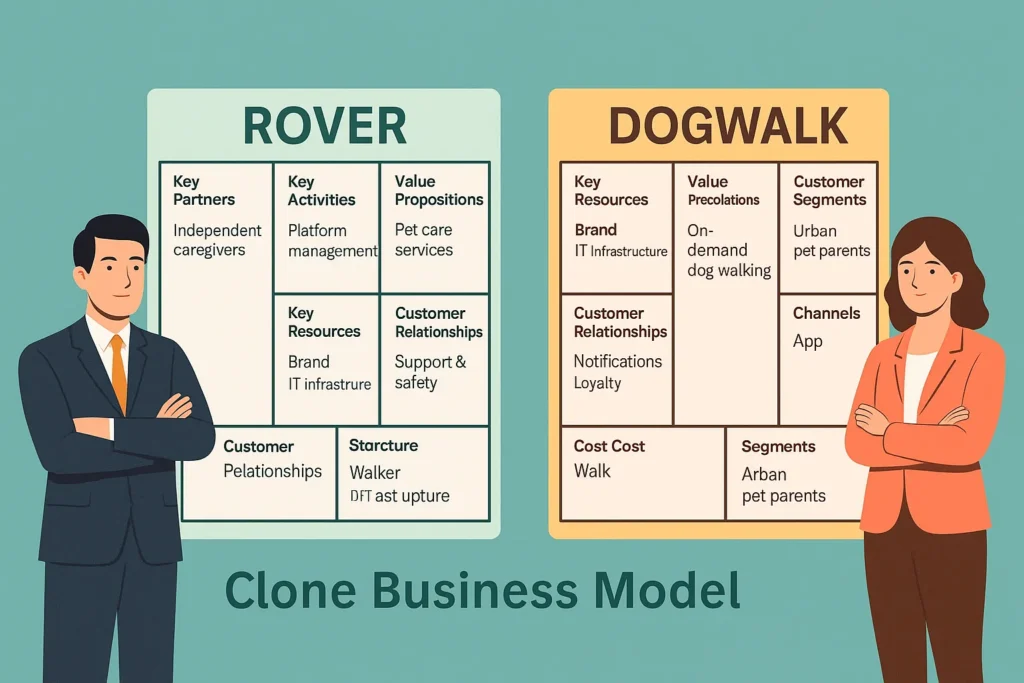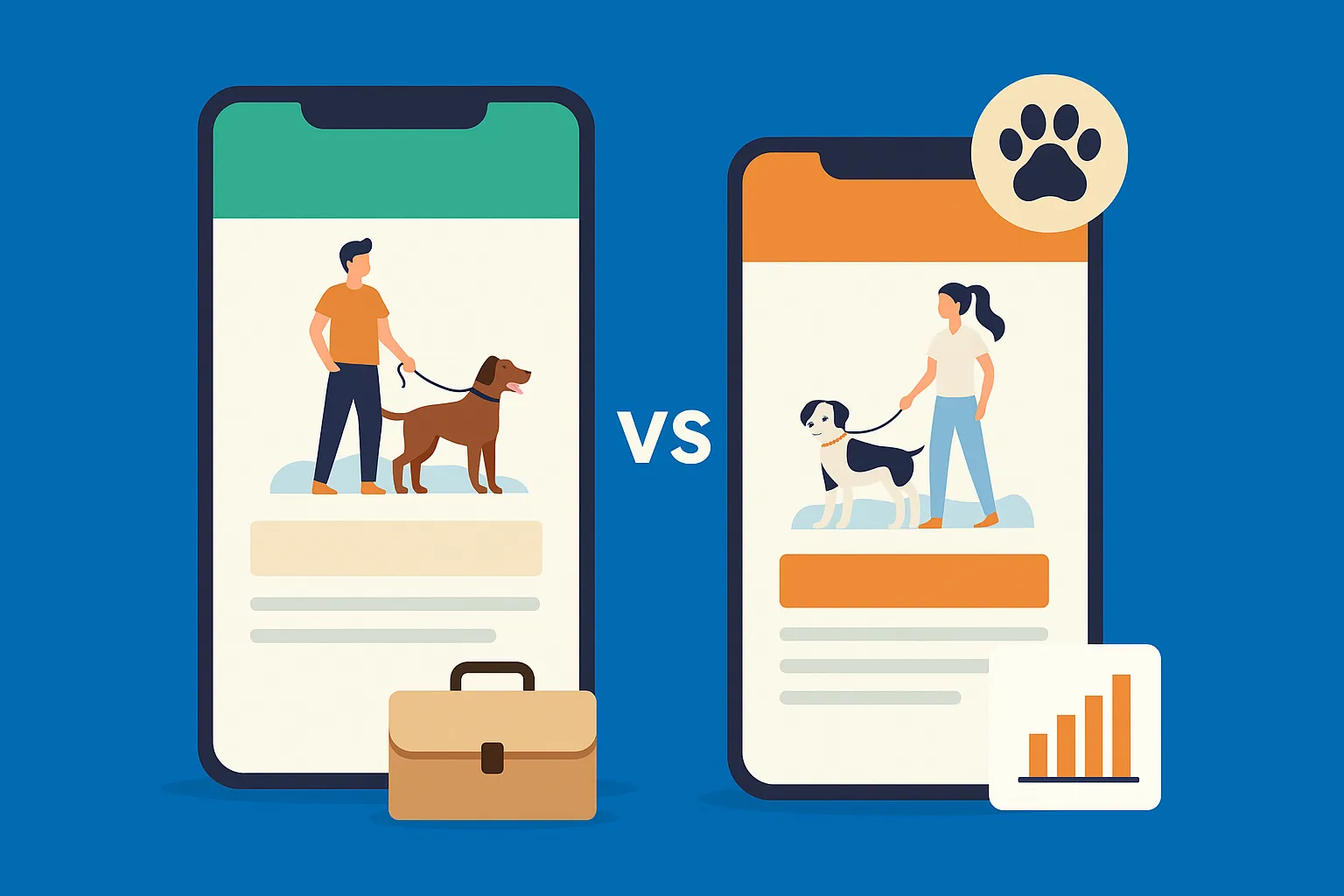The global pet care industry is booming—and in 2025, it’s more digital, personalized, and on-demand than ever before. Pet ownership has reached record highs, and with more people working flexible hours or remotely, services like dog walking, pet sitting, and grooming are now tech-enabled and app-based. For entrepreneurs exploring the pet care vertical, choosing the right business model is essential.
Two leading players in this space are Rover and DogWalk—each representing distinct operational strategies. Rover is the dominant full-scale marketplace for pet care services, while DogWalk is a leaner, hyperlocal service-oriented model that emphasizes personal connections and route optimization.
For startup founders and app entrepreneurs in 2025, understanding the Rover vs DogWalk business model comparison will help determine which framework better aligns with your goals, market, and capital resources.
Let’s start with a closer look at each platform.

What is Rover?
Rover is the largest online marketplace for pet care services in North America and parts of Europe. Founded in 2011, Rover offers:
- Dog walking
- Pet sitting
- Drop-in visits
- Boarding
- Doggy daycare
The platform operates on a two-sided marketplace model that connects pet owners with independent caregivers. Rover vets service providers, handles payments, and provides customer support, while users browse, book, and review caregivers through the app.
What is DogWalk?
DogWalk (a conceptual name used here to represent a streamlined local pet walking service model) is a hyperlocal, on-demand dog walking app. Unlike Rover, which offers a wide range of pet services, DogWalk focuses primarily on:
- Real-time dog walking
- Route tracking
- Daily scheduling
- Push notifications for walk updates
DogWalk often employs or contracts dedicated walkers within city blocks or neighborhoods. Its business model leans toward centralized coordination, less marketplace complexity, and quick scalability in dense urban regions.
Business Model of Rover
Revenue Streams
- Commission Fees: Rover takes ~20-25% from each booking made on the platform
- Premium Listings: Pet caregivers can pay for better visibility
- Rover Guarantee Fee: Covers insurance and safety support
- Value-Added Services: Includes photo updates, report cards, and customer support access
Cost Structure
- App and tech infrastructure
- Customer service and fraud prevention
- Marketing (online + affiliate)
- Pet caregiver onboarding and background checks
- Insurance and legal support
Key Partners
- Pet caregivers (independent contractors)
- Payment gateways
- Pet insurance providers
- Local law enforcement for verification
Growth Strategy
- Expand geographically in pet-dense cities
- Add pet grooming and training options
- Build trust with review and rating systems
- Partnership with shelters and vet clinics
Learn More: Business Model of Rover : Revenue & Strategy Guide
Business Model of DogWalk
Revenue Streams
- Subscription Plans for pet owners (daily/weekly walk packages)
- One-time Booking Fees
- Surge Pricing during peak walking hours
- In-app Store (leashes, collars, etc.)
- Tips (optional but encouraged)
Cost Structure
- Salaries or contracts for dog walkers
- Real-time GPS tracking infrastructure
- Insurance and pet safety tools
- Local advertising and brand activation
- Training for walkers
Key Partners
- Local dog walkers
- GPS mapping providers
- Insurance firms
- Pet accessory brands
Growth Strategy
- Launch in high-density neighborhoods
- Partner with condos, pet-friendly hotels
- Loyalty incentives for repeat clients
- Expansion to midday puppy visits or cat care
Comparison Table: Rover vs DogWalk
| Feature | Rover | DogWalk |
|---|---|---|
| Business Model | Marketplace for all pet services | On-demand hyperlocal walking service |
| Revenue Source | Commission, premium listings | Subscription, direct fees |
| Logistics | User and provider coordinated | Platform coordinated |
| Scalability | Moderate (needs vetting, trust) | High (faster onboarding) |
| Upfront Cost | Medium to high | Low to medium |
| Market Focus | Nationwide and international | Local and dense urban clusters |
| Service Variety | High – walks, sitting, boarding | Low – primarily walking |
| Profitability Timeline | Longer-term | Quicker breakeven |
Pros & Cons of Rover Model
Pros
- Wide range of services = more revenue streams
- Brand trust and user reviews build network effects
- Flexible for pet caregivers
- Insurance and support system boost credibility
Cons
- More complex to manage
- High operational cost for vetting and support
- Tougher to scale in new cities without trust base
- Heavier reliance on gig economy model
Pros & Cons of DogWalk Model
Pros
- Simple and focused offering
- Easy to launch in multiple neighborhoods
- High user retention due to daily need
- Streamlined logistics with route optimization
Cons
- Limited service = limited monetization
- Needs frequent walker availability
- Less community engagement than a marketplace
- Lower perceived value vs. full-service app
Market Data: Growth, Revenue & Funding
Pet Tech Industry in 2025
- Global pet care market expected to surpass $325 billion by 2025
- Pet tech sector experiencing CAGR of 24%
- 72% of millennials consider pets as “starter children”
Rover Stats
- Annual Revenue (2024): $215M+
- Funding Raised: $310M+
- Monthly Bookings: Over 2 million
- Expanded across 10+ countries
DogWalk Insights (model-based estimate)
- Used in over 25 cities (conceptual model)
- Revenue potential of $8–15K/month per location
- Break-even time: 6-8 months
- Popular among urban pet parents with busy schedules
Which Model is Better for Startups in 2025?
In 2025, the choice depends on your vision, market, and budget:
- Rover-style marketplace is great if you’re building a comprehensive pet care ecosystem, aiming for long-term growth, and can manage a complex two-sided platform.
- DogWalk-style apps are ideal for lean startups, targeting specific urban areas with quick monetization and minimal overhead.
Both models are valid, but DogWalk wins in speed-to-market and simplicity, while Rover excels in breadth and brand loyalty.
Choose Rover-Style If…
- You’re building a full-service pet care platform
- You have access to moderate funding
- You want to focus on urban-to-suburban scaling
- Your goal is to create a community of pet caregivers
Build a custom Rover Clone App with Miracuves
Choose DogWalk-Style If…
- You want a quick-launch model
- You’re targeting high-density urban areas
- You prefer single-service simplicity
- You want lower risk and quicker ROI
Launch your DogWalk Clone App with Miracuves
Conclusion
Whether you’re leaning toward the all-in-one capabilities of Rover or the streamlined, local power of DogWalk, the path to success lies in execution, agility, and the right tech partner.
Miracuves is your expert in custom app development for pet tech, marketplace platforms, and hyperlocal services. From MVP to scaling, we help you build secure, feature-rich, and scalable clone apps tailored to your business model.
Ready to take the lead in the booming pet industry?
FAQs
1. What is the main difference between Rover and DogWalk?
Rover is a full-service marketplace connecting pet owners with a variety of pet caregivers. DogWalk focuses on real-time, hyperlocal dog walking with fewer services but quicker execution.
2. Which app model is more profitable in the short term?
DogWalk’s model offers quicker break-even and profitability due to its low overhead and subscription-based model.
3. Can I build a Rover-like app without a large team?
Yes, with the right development partner like Miracuves, you can launch a Rover-style app with scalable backend and marketplace tech.
4. Which model is better for Tier 1 cities?
DogWalk excels in Tier 1 cities with dense populations and high daily demand for dog walking.
5. Do both models require insurance and compliance?
Yes. Regardless of the model, pet safety and local laws require insurance coverage, background checks, and user protection protocols.








